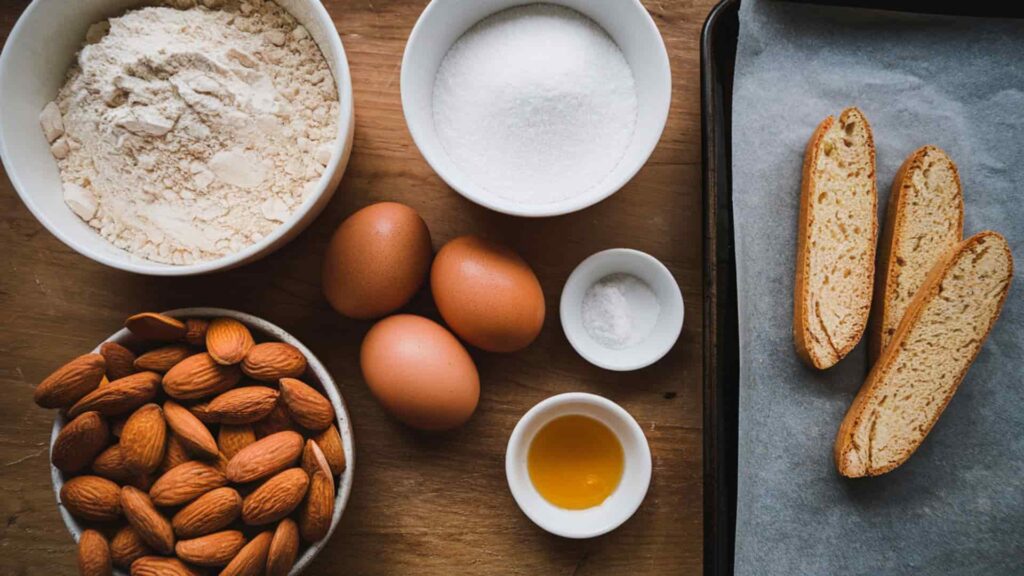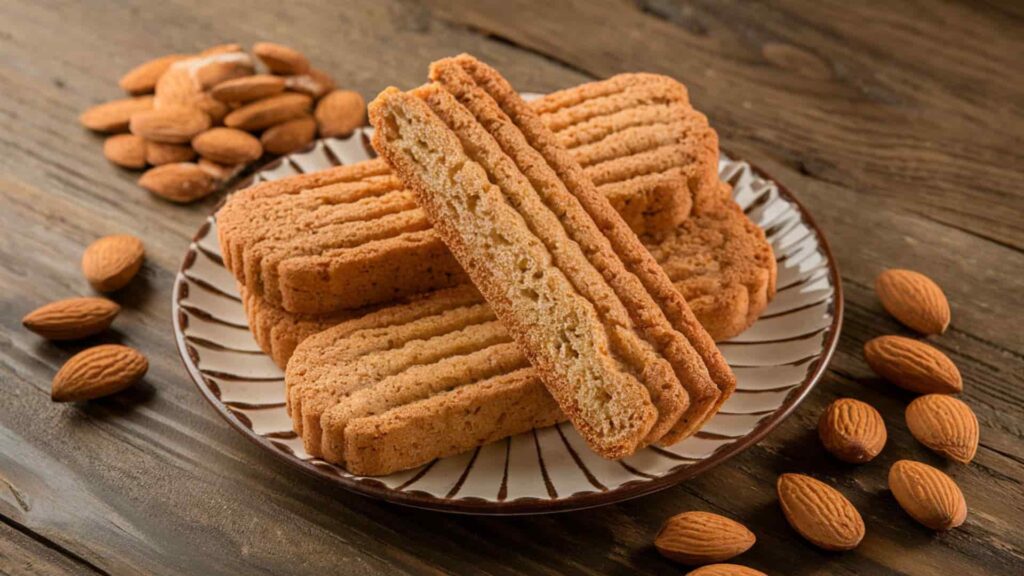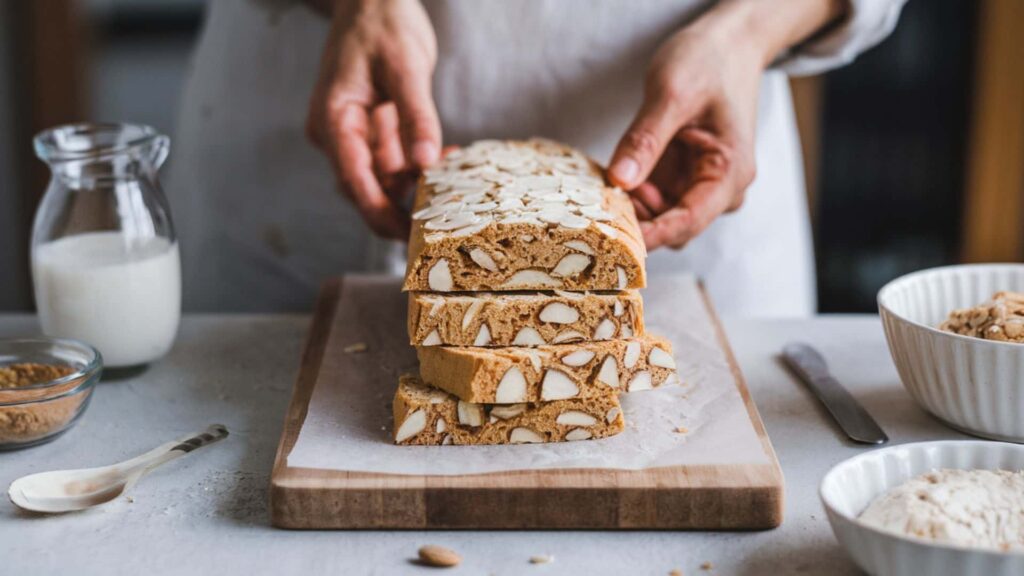Бишкоти ди Прато – Recipe & Best Baking Tips!

When you think of Italy’s rich culinary heritage, images of pasta, pizza, and gelato might flood your mind. But nestled among these giants is a crunchy, humble treasure: бишкоти ди прато.
Born in the charming city of Prato, this twice-baked almond cookie has transcended borders, delighting dessert lovers across the globe.
In this comprehensive guide, we’ll explore the origins, ingredients, preparation methods, cultural significance, modern adaptations, and why бишкоти ди прато continue to hold a special place in both Italian hearts and global dessert tables.
What Exactly Is Бишкоти ди Прато?
At its core, бишкоти ди прато refers to traditional almond cookies that are twice-baked to achieve a distinctive crispness. Unlike softer American cookies, these Italian treats are dry and firm, designed specifically for dipping into coffee, tea, or sweet wines.
Their simplicity is their genius: basic ingredients, a clever baking technique, and the ability to stay fresh for months made them a beloved treat not just for families but also for travelers and merchants throughout history.
The Historical Roots of Бишкоти ди Прато – Don’t Miss Out!
The Birthplace: Prato, Tuscany: Prato, a medieval city in Tuscany, is more than just the home of stunning art and architecture. It gave the world a cookie that carries the city’s name with pride.
The earliest versions of biscotti date back to the Roman Empire, where twice-baked breads were common for soldiers. However, it was in Prato that the sweet, almond-studded version evolved into what we know today as бишкоти ди прато.
Historical documents from the 14th century describe almond-laden cookies, but it wasn’t until the Renaissance that they truly flourished, thanks in part to Prato’s growing affluence and access to fine ingredients like almonds and sugar.
Why “Biscotti” Means “Twice-Cooked”?
The very word “biscotti” is rooted in the Latin bis (twice) and coctus (cooked).
This double-baking method was revolutionary: it ensured that the cookies could be stored for long periods without spoiling, a crucial feature before refrigeration.
Today, double-baking defines the very soul of бишкоти ди прато, making them both practical and delicious.
Ingredients You’ll Need for Authentic Бишкоти ди Прато:

Making traditional бишкоти ди прато is refreshingly straightforward. Here’s a basic list of ingredients:
- 2 cups all-purpose flour
- 1 cup granulated sugar
- 3 large eggs
- 1 cup whole raw almonds (unpeeled)
- 1 teaspoon baking powder
- A pinch of salt
- Optional: 1 teaspoon vanilla extract or orange zest
Notably, there’s no butter or fat in the original recipe. This keeps the texture dry and crisp — essential for proper dipping!
Step-by-Step – How Бишкоти ди Прато Is Made?
Creating the perfect batch of бишкоти ди прато is an art form.
Here’s a step-by-step overview:
- Mixing the Dough: Combine flour, sugar, eggs, and flavorings into a sticky dough. Add whole almonds at the end.
- Shaping the Logs: Roll the dough into elongated, slightly flattened logs.
- First Bake: Bake the logs at a moderate temperature until firm but not fully dry.
- Cooling: Allow the logs to cool slightly, which firms up the structure for slicing.
- Slicing: Using a serrated knife, slice the logs diagonally into individual cookies.
- Second Bake: Return the slices to the oven to dry out and become crisp.
Quick Tip: Slice while the logs are still slightly warm — it prevents crumbling and maintains the elegant shape!
Traditional Pairings – How Italians Enjoy Бишкоти ди Прато?
In Italy, бишкоти ди прато is rarely eaten alone. Tradition suggests pairing them with:
- Vin Santo: A sweet, golden dessert wine from Tuscany. Dip the biscotti briefly to soften and enrich the flavors.
- Coffee or Espresso: Perfect for breakfast or an afternoon pick-me-up.
- Tea: Especially black teas like Earl Grey, where the strong flavors balance the almond sweetness.
Dipping isn’t just optional — it’s almost a ritual that elevates the simple cookie into an indulgent experience.
Cultural Significance of Бишкоти ди Прато in Tuscany:
In Tuscany, бишкоти ди прато isn’t just food — it’s memory, community, and pride.
- Holiday Traditions: Families often bake and gift biscotti during Christmas and Easter.
- Celebrations: Weddings and baptisms often feature biscotti alongside other traditional sweets.
- Culinary Pride: Prato bakeries compete to offer the most authentic, perfect version.
The cookie acts as a bridge between generations, a sweet bite of nostalgia for many Italians.
The Evolution of Бишкоти ди Прато – Modern Twists!
While traditionalists prefer the original recipe, modern chefs and home bakers have embraced creativity:
- Chocolate-Dipped: One side dipped in dark or white chocolate.
- Different Nuts: Pistachios, hazelnuts, or walnuts instead of almonds.
- Fruit Additions: Dried cherries, cranberries, or apricots for extra texture.
- Spices: Cinnamon, nutmeg, or cardamom for a modern flavor twist.
Each variation pays homage to the classic while introducing new layers of complexity.
Top 5 Mistakes to Avoid When Baking Бишкоти ди Прато:

Bишкоти ди Прато, or Biscotti di Prato, are famous Italian twice-baked almond cookies known for their signature crunch.
Baking them perfectly requires some care — small mistakes can easily ruin the texture or flavor. Let’s go over the top 5 common mistakes you should avoid when making Бишкоти ди Прато.
1. Not Bringing Ingredients to Room Temperature:
One of the basic baking rules is using room-temperature ingredients. If you use cold eggs or chilled butter, the dough won’t blend properly, which can lead to uneven texture and cracks during baking.
Tip: Take out your eggs, butter, and other ingredients at least 30–40 minutes before you start baking.
2. Overmixing the Dough:
Overmixing is a common error, especially if you’re used to baking soft cookies. But for Бишкоти ди Прато, you want a crisp texture — too much mixing builds gluten and results in dense, hard biscotti.
Tip: Once your dry and wet ingredients are just combined, stop mixing immediately.
3. Overbaking the First Time:
The magic of Бишкоти ди Прато lies in the second bake, not the first. If you overbake the loaf during the first baking, it can become too dry and crumble apart when you slice it.
Tip: Bake just until the loaf is set and lightly golden — it should still be a little soft inside.
4. Slicing the Loaf Too Hot or Too Cold:
Timing is crucial when slicing.
If the loaf is too hot, it will fall apart.
If it’s too cold, it can crack and break unevenly.
Tip: After the first bake, let the loaf cool for about 5–10 minutes. Then, slice with a sharp serrated knife while it’s still slightly warm.
5. Rushing or Overheating the Second Bake:
The second baking is where Бишкоти ди Прато get their famous crispness. If you rush it or use too high a temperature, the cookies can burn or stay chewy inside.
Tip:
- Bake at a low to medium temperature (around 150°C / 300°F).
- Flip the slices halfway through to ensure even crisping on both sides.
A Look at Authentic vs. Commercial Бишкоти ди Прато
While homemade or artisanal versions stay true to tradition, mass-produced biscotti sometimes:
- Add preservatives for shelf life
- Include oils or butter for softer texture
- Use cheaper nuts or artificial flavorings
For a true taste of Tuscany, always seek artisanal бишкоти ди прато or better yet, try baking them at home!
Are Бишкоти ди Прато Healthy – Nutritional Information!
Surprisingly, бишкоти ди прато can be relatively healthy compared to other desserts:
| Nutritional Component | Details (Approximate) |
| Calories | 90-100 per cookie |
| Fat | Low (mainly from almonds) |
| Protein | Moderate (almonds + eggs) |
| Sugar | Moderate |
| Fiber | Good (if almonds are unpeeled) |
Because they’re free of butter and loaded with almonds, they offer some healthy fats and proteins, making them a more wholesome indulgence when eaten in moderation.
How To Store Бишкоти ди Прато Properly?

Due to their dry texture, бишкоти ди прато have an impressively long shelf life if stored correctly:
- Airtight Container: Keeps out moisture.
- Cool, Dry Place: Avoid humid kitchens.
- Freezing: They freeze beautifully — just thaw and enjoy!
Stored properly, they can last for up to three months without losing flavor or crunch.
FAQs About Бишкоти ди Прато:
1. What makes Бишкоти ди Прато different from other biscotti?
Бишкоти ди прато specifically refers to the traditional almond biscotti from Prato, Tuscany. It sticks to a classic recipe without modern flavor additions.
2. Can I make Бишкоти ди Прато without almonds?
Traditionally, no. Almonds are essential. However, some variations use pistachios, hazelnuts, or even pine nuts. If you have a nut allergy, you can experiment with seeds like sunflower or pumpkin seeds, but it won’t be the authentic version. Almonds contribute to both the signature taste and the crunch.
3. Are Бишкоти ди Прато gluten-free?
The traditional recipe uses wheat flour. To make them gluten-free, substitute with a gluten-free flour blend. Look for a blend that includes xanthan gum to help maintain the cookie’s structure. Keep in mind that the texture might be slightly different from the classic version.
4. Can I add chocolate to Бишкоти ди Прато?
Yes, modern recipes often include chocolate chips or dip the finished biscotti in chocolate. Though delicious, adding chocolate moves the cookie away from its traditional roots. For a balanced flavor, try using dark chocolate for dipping only.
5. How long does Бишкоти ди Прато stay fresh?
Properly stored, they can remain fresh and delicious for up to three months. Use an airtight container and keep them in a cool, dry place to maintain their crispness. You can also lightly re-toast them if they start to soften over time.
6. Is it necessary to double-bake the cookies?
Yes, the second bake is crucial to achieve the dry, crunchy texture that defines Бишкоти ди Прато. Skipping the second bake would leave the cookies soft inside, making them closer to a regular cookie than authentic biscotti. The twice-baked method ensures a perfect snap.
7. How thin should I slice the biscotti after the first bake?
About ½ inch thick slices are ideal for even crisping without burning. Use a sharp, serrated knife and gentle sawing motions to avoid breaking the slices. Uniform thickness also helps them bake consistently in the second round.
Conclusion:
In the world of desserts, бишкоти ди прато stands apart. Their simplicity belies a deep-rooted history of craftsmanship, practicality, and flavor.
By honoring traditional recipes while welcoming creative twists, we can keep this beloved cookie alive for generations to come. Whether dipped in a luscious sweet wine or nibbled with a strong espresso, бишкоти ди прато invite us to savor every moment — one delicious, crunchy bite at a time.
Latest Post:







